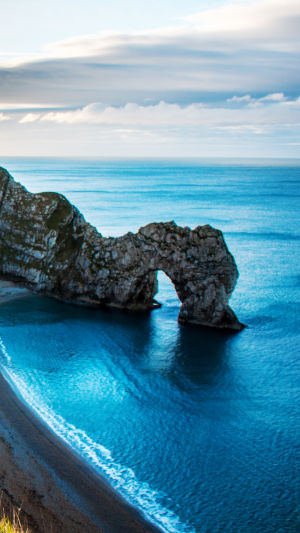Sculpted by time and tide, Durdle Door is not just a striking natural arch; it is a testament to the Earth's enduring power to create and shape wondrous sights.
This magnificent geological formation owes its existence to the relentless forces of nature that have, over millions of years, eroded the softer rocks around the harder limestone, crafting the archway we behold today.
The name "Durdle" comes from the Old English word 'thirl,' meaning to drill or bore, aptly describing the ocean's actions throughout the ages. This iconic landmark has become a symbol of the United Kingdom's natural heritage and a subject of countless photographs, artworks, and inspirations for storytellers. One might argue that Durdle Door has a story to tell, one written in its layers of rock that date back to approximately 140 million years ago. As part of the Jurassic Coast, a World Heritage Site, it offers a rare glimpse into the distant past, where Earth's history is etched into the very stone itself.
<h3>Introduce Durdle Door</h3>
<b>1. The Best Time to Visit</b>
The ideal time to visit Durdle Door is during the late spring or early summer months. From May to June, visitors can enjoy mild weather, fewer crowds, and the surrounding countryside adorned with blooming wildflowers. Late summer and early autumn also provide excellent visiting conditions, though the area tends to be more crowded.
<b>2. Geographical Location</b>
Perched on the southern coast of England, near the town of Lulworth in Dorset, Durdle Door is accessible through the Lulworth Estate. This impressive structure belongs to a stretch of coastline that spans about 95 miles, designated as the Jurassic Coast because of its geological significance and stunning landscapes showcasing millions of years of Earth's history.
<b>3. The Charm of This Tourist Place</b>
Durdle Door's allure extends far beyond its visual appeal. It epitomizes the enduring battle between land and sea, a spectacle that has a profound impact on visitors. The arch attracts geologists, nature lovers, and photographers alike, each drawn to the majesty of its form and the dramatic backdrop it sets against the azure sea.
<b>4. Activities in the Surrounding Area</b>
Visitors to Durdle Door will find no shortage of activities to enrich their experience of the Jurassic Coast. Just a short hike away lies Lulworth Cove, another geological marvel with a perfect horseshoe bay that offers a peaceful retreat for beachgoers. The nearby Lulworth Castle and Park can satisfy those interested in history and architecture. It is open from 10:30-17:00 except on Fridays. And the place is free for children under the age of four, with adults paying nine euros.
<h3>Tips for Travelling to This Place</h3>
1. Wear appropriate footwear as the paths leading to Durdle Door and the surrounding cliffs can be steep and uneven.
2. Check the tidal charts before planning your visit if you wish to spend time on the beach below the arch.
3. Respect the fragile natural environment by following local guidelines and disposing of any waste responsibly.
Durdle Door stands as a remarkable sentinel, guarding the secrets of Earth's prehistoric past and inspiring those who come to witness its grandeur. A journey here is one of discovery, offering insight into our planet's geological drama and the pure joy of experiencing nature's artistry. Whether basking in the quietude of an early morning visit or capturing the golden hues of a sunset, Durdle Door is a destination that truly encapsulates the wonder of the natural world.





